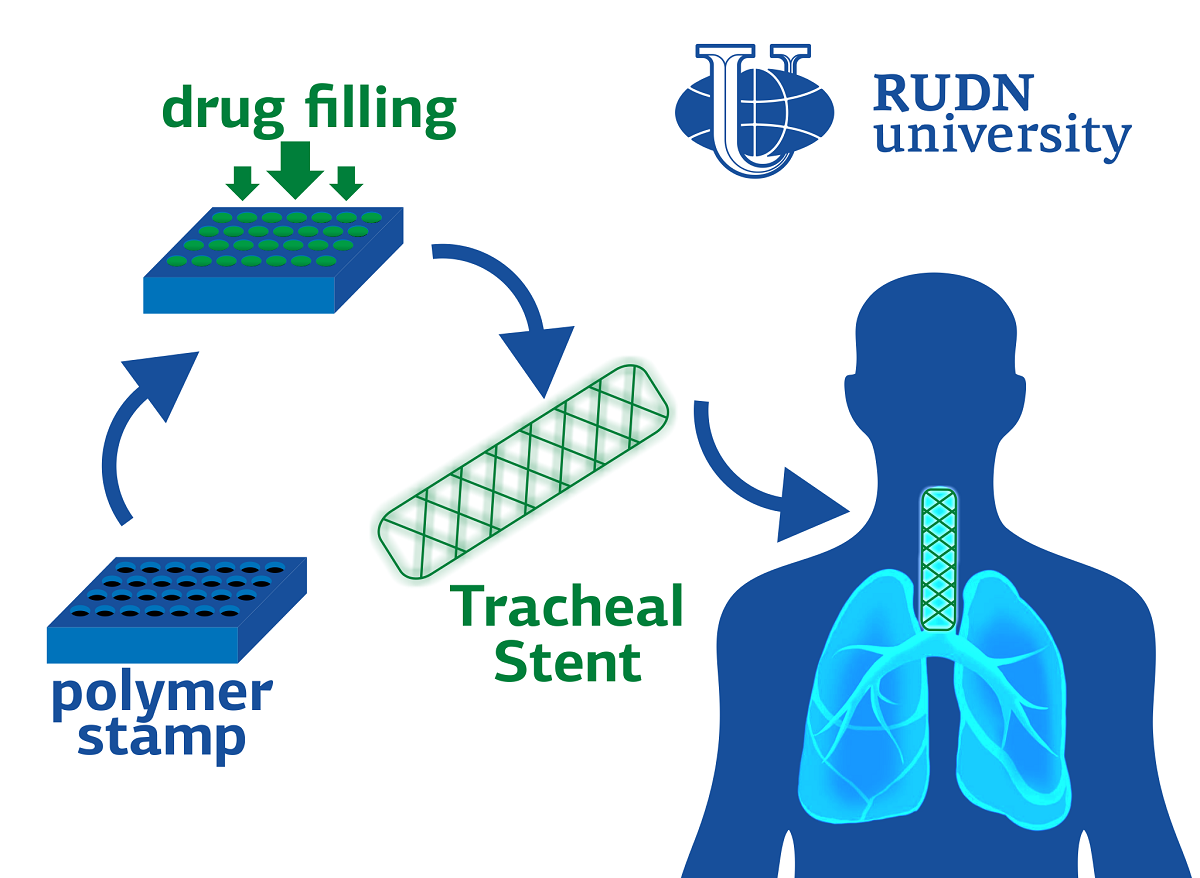RUDN University Researchers Create a Drug Coating for Tracheal Stents

Airway obstruction is treated by installing a tracheal stent. This is a hollow tube that opens the narrowed area and restores breathing. If the surface of the stent is not covered with drug, then such treatment can damage the walls of the trachea and increase the narrowing — in response to damage, inflammation, swelling, and scarring may occur. The scientists from Innovative Engineering Technologies Institute at RUDN University together with colleagues from Queen Mary University of London and Skoltech have developed a coating for stents made of polymer films with micropores containing drug. It prevents inflammation and restenosis.
“Drug-eluting coatings have been used widely in cardiology for many years to suppress local granulation and reduce the organism’s systemic load. Still, so far, there are no available analogs for the trachea. We demonstrate that plymers based films with arrays of microchambers to accommodate therapeutic substances can be used as a drug-eluting coating on the surface of a stent”, said Sergey Goriainov, the Head of High-resolution NMR Spectroscopy and Mass Spectrometry Laboratory of RUDN University’s Shared Research and Educational Center.
A team of scientists has developed a coating with a drug. It can be applied to the stent to eliminate the side-effects of stenting. The scientists tested the operation of the coated stent in experimental studies with animals.
To create the coating, the scientists used an 8×8 mm wide polydimethylsiloxane (PDMS) stamp with microwells of 10 micrometers in diameter. The stamp was dipped for 3 seconds in a chloroform solution of a biodegradable polymer — polycaprolactone (PCL), polylactic acid (PLA) or polylactide-glycolide (PLGA). After drying, a thin polymer film with wells formed on the stamp, which were then filled with an anti-inflammatory drug (methylprednisolone). Similarly, thin polymer films with a size of 76×26 mm were formed and “covered” by the film with the drug. That way they obtained a microstructure similar to a blister pack. Each microblister contained 12 portions of medicine. The resulting coating was applied to the walls of the stent and tested on rabbits. Stents were installed in the trachea of the animals for 10 days. During this time, the polymers decomposed, gradually releasing the drug.
Experimental studies have shown that coatings based on three polymers demonstrate different properties. For example, PCL and PLA turned out to be the most stable. Therefore, these polymers can be used, for example, for drugs with a large molecular weight. PLGA turned out to be less durable — by the time the stent was installed, only 15.7% of the drug remained, but clinical trials on rabbits showed that this amount was enough to achieve a therapeutic effect. Probably, the fact is that the PLGA coatings dissolved faster and released the drug, whereas the films from the stronger PCL dissolved slowly and made it difficult for the drug to release. PLA blisters decomposed slower than PLGA, but contained the most drugs — as a result, they provided a more prolonged therapeutic effect. Scientists considered PLGA-based films to be the most promising coating, as they quickly allowed the drug to come out. However, depending on the specific clinical case, all three polymers can be used.
“Further study could optimize polymer compositions considering the opportunity to blend the polymers to ensure proper therapeutic cargo encapsulation and mechanical properties”, said Nikolay Sedykh of RUDN University’s Innovative Engineering Technologies Institute.
The results are published in Pharmaceuticals.
RUDN summarized the results of the scientific competition "Project Start: work of the science club ". Students of the Faculty of Physics, Mathematics and Natural Sciences have created a project for a managed queuing system using a neural network to redistribute resources between 5G segments. How to increase flexibility, make the network fast and inexpensive and reach more users — tell Gebrial Ibram Esam Zekri ("Fundamental Computer Science and Information Technology", Master's degree, II course) and Ksenia Leontieva ("Applied Mathematics and Computer Science", Master's degree, I course).
The National Demographic Report, 2023 Demographic Well-Being of Russian Regions (hereinafter - the National Demographic Report) was prepared by the scientific team of the Institute of Demographic Studies of the Federal Research Center of the Russian Academy of Sciences, the Vologda Scientific Center of the Russian Academy of Sciences, Peoples' Friendship University of Russia, the Center for Family and Demography of the Academy of Sciences of the Republic of Tatarstan, as well as with the participation of leading scientists from the Republic of Bashkortostan, Stavropol Krai, Volgograd, Ivanovo, Kaliningrad, Nizhny Novgorod, Sverdlovsk Oblasts and Khanty-Mansi Autonomous Okrug–Yugra.
RUDN summarized the results of the scientific competition "Project Start: work of the science club ". Students of the Faculty of Physics, Mathematics and Natural Sciences have created a project for a managed queuing system using a neural network to redistribute resources between 5G segments. How to increase flexibility, make the network fast and inexpensive and reach more users — tell Gebrial Ibram Esam Zekri ("Fundamental Computer Science and Information Technology", Master's degree, II course) and Ksenia Leontieva ("Applied Mathematics and Computer Science", Master's degree, I course).
What is your first association with the word “laboratory”? Flasks and beakers? Microscopes and centrifuges? Yes, many of us would answer the same way.
The National Demographic Report, 2023 Demographic Well-Being of Russian Regions (hereinafter - the National Demographic Report) was prepared by the scientific team of the Institute of Demographic Studies of the Federal Research Center of the Russian Academy of Sciences, the Vologda Scientific Center of the Russian Academy of Sciences, Peoples' Friendship University of Russia, the Center for Family and Demography of the Academy of Sciences of the Republic of Tatarstan, as well as with the participation of leading scientists from the Republic of Bashkortostan, Stavropol Krai, Volgograd, Ivanovo, Kaliningrad, Nizhny Novgorod, Sverdlovsk Oblasts and Khanty-Mansi Autonomous Okrug–Yugra.